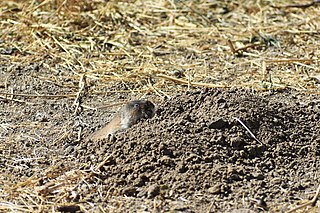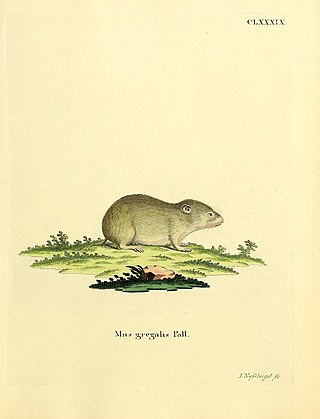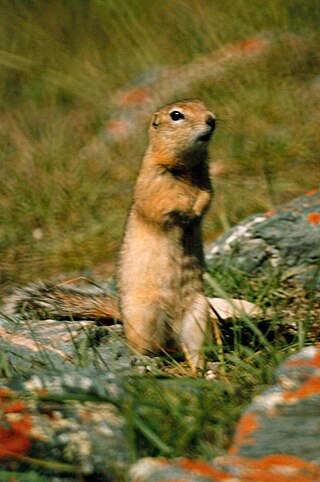
Peter Leopold von Schrenck was a Russian zoologist, geographer and ethnographer.

Carl Johann Maximovich, also Karl Ivanovich Maximovich was a Russian botanist. Maximovich spent most of his life studying the flora of the countries he had visited in the Far East, and naming many new species. He worked at the Saint Petersburg Botanical Gardens from 1852 as curator of the herbarium collection, becoming Director in 1869.

The Arvicolinae are a subfamily of rodents that includes the voles, lemmings, and muskrats. They are most closely related to the other subfamilies in the Cricetidae. Some authorities place the subfamily Arvicolinae in the family Muridae along with all other members of the superfamily Muroidea. Some refer to the subfamily as the Microtinae or rank the taxon as a full family, the Arvicolidae.

The tundra vole or root vole is a medium-sized vole found in Northern and Central Europe, Asia, and northwestern North America, including Alaska and northwestern Canada. In the western part of the Netherlands, the tundra vole is a relict from the ice age and has developed into the subspecies Alexandromys oeconomus arenicola.

The rock vole, also known as the yellow-nosed vole, is a medium-sized species of vole found in eastern North America.

The gray-tailed vole also known as the gray-tailed meadow vole or gray-tailed meadow mouse, is a rodent in the genus Microtus of the family Cricetidae. Voles are small mammals, and this species lies roughly in the middle of their size range. First collected in 1895, it is endemic to the Willamette Valley, Oregon, and Clark County, Washington, in the Pacific Northwest region of North America. Historically, they were found in the prairie areas of the Valley and, though many of these areas have been converted for agricultural purposes, these animals remain common. For reasons that remain unclear, vole population densities in any area may fluctuate widely from season to season and year to year. They are preyed upon by owls, hawks, and carnivorous mammals, and their parasites include fleas and ticks. These voles build burrows and complex tunnel networks, which they sometimes share with other burrowing animals. Relatively little is known about their behavior in the wild, because they are elusive and unlikely to enter traps.

Elaphe schrenckii is a species of nonvenomous snake in the family Colubridae. The species is indigenous to Northeast Asia.

The Chinese striped hamster, also known as the striped dwarf hamster, is a species of hamster. It is distributed across North Asia from southern Siberia through Mongolia and northeastern China to northern North Korea. An adult Chinese striped hamster weighs 20 to 35 g, and has a body length of 72 to 116 mm with a tail of 15 to 26 mm. It is smaller and has a much shorter tail than the greater long-tailed hamster, Tscherskia triton, which inhabits much of the same range.

The reed vole is a species of vole. It is found in northern and central Eurasia, including northern China and the Korean Peninsula. This species is somewhat larger and longer-tailed than most other voles.
Sokolov's dwarf hamster is a species of rodent in the hamster and vole family Cricetidae. Previously listed as conspecific with Chinese striped hamster, it has been listed as a separate species since 1988. It has a distinctive dark stripe down its back on and otherwise grey body. It is found in China and Mongolia, and lives in burrows beneath desert shrubs.

The Zaisan mole vole, or eastern mole vole, is a species of rodent in the family Cricetidae. It is found in central Asia.
The Ganzu vole, Eva's red-backed vole, Eva's vole, Gansu vole, or Taozhou vole is a species of rodent in the family Cricetidae. It is found in mountain forests in China. The IUCN has assessed it as being of "least concern".
The Kolan vole, Inez's red-backed vole or Inez's vole is a species of rodent in the family Cricetidae. It is found only in China. Two subspecies have been recognized, Caryomys inez inez from the northern part of its range and Caryomys inez nux from the southern part.

The narrow-headed vole is a species of rodent in the family Cricetidae. It was previously placed in the genus Microtus, but modern listings either lump this into genus Lasiopodomys or split it out into Stenocranius. It ranges over northern and central Asia.
The Chinese scrub vole, or Irene's mountain vole, is a species of rodent in the family Cricetidae. It is endemic to mountainous parts of southern China and is very similar to the Sikkim mountain vole in appearance. The International Union for Conservation of Nature has assessed its conservation status as being of "least concern".

Blyth's vole is a species of rodent in the family Cricetidae. It was previously the only species in the genus Phaiomys, but was moved to Neodon in 2016. It is found in mountainous regions in northern India, Nepal and China. It is a burrowing rodent and lives in small colonies. It has a wide distribution and faces no particular threats so the International Union for Conservation of Nature has assessed its conservation status as being of "least concern".

Townsend's vole is a species of rodent in the family Cricetidae, the sister species of M. canicaudus. It is found in temperate grasslands of British Columbia in Canada and in the states of Washington and Oregon in the United States.

The Chinese zokor is a species of rodent in the family Spalacidae. It is endemic to China, ranging from Qinghai Province eastwards to Beijing in steppe and alpine grasslands. Henri Milne-Edwards first described it in 1867. Eradication programs in the 1990s in Qinghai Province resulted in a population decline to less than a third of the former population. It is considered common and has been assessed as Least Concern by IUCN.

The long-tailed ground squirrel or Eversmann's souslik is a species of rodent in the squirrel family Sciuridae. It is found in China, Kazakhstan, Mongolia, and Russia.

The Daurian forest steppe ecoregion is a band of grassland, shrub terrain, and mixed forests in northeast Mongolia and the region of Siberia, Russia that follows the course of the Onon River and Ulz River, and part of the northwestern China. The region has been described as a "sea of grass that forms the best and most intact example of an undisturbed steppe ecosystem and is also one of the last areas in the Palearctic that still supports stable herds of larger vertebrates" in a semi-mountainous area. The area also has flat wetlands that are important to migratory birds. The ecoregion is in the Palearctic realm, with a dry-winter subarctic climate that borders on a very cold semi-arid climate (BSk) in its southwestern parts. It covers 209,012 km2 (80,700 sq mi).
















